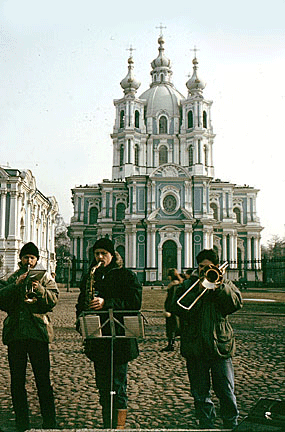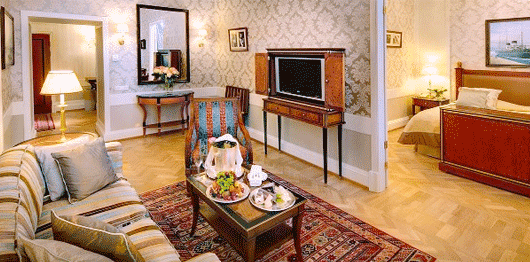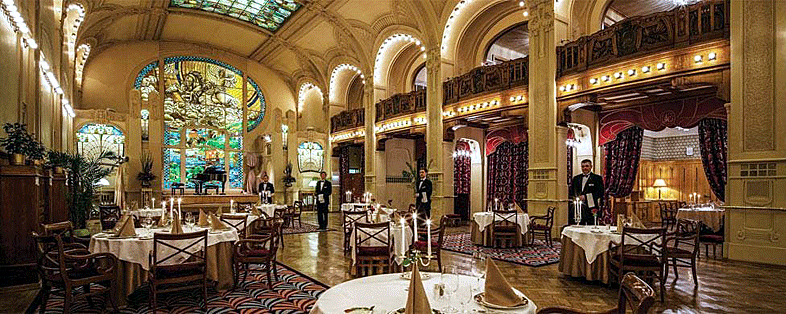 The Russians have a saying, "Better to see it
once than hear about it one hundred times." And seeing is believing. For
if I hadn't seen it with my own eyes, I wouldn't have believed it. A
luxurious style of travel, once reserved for the Czar and his court, is
now available in the new Russia for anyone who can afford it. The Russians have a saying, "Better to see it
once than hear about it one hundred times." And seeing is believing. For
if I hadn't seen it with my own eyes, I wouldn't have believed it. A
luxurious style of travel, once reserved for the Czar and his court, is
now available in the new Russia for anyone who can afford it.
With the sweep of new power has come a plethora of new or restored
hotels, new cooperative restaurants, and a new level of service unheard
of in Russia since before the Revolution. Old Russian culture—the
splendor of Imperial Russia--is being revived.
The most dramatic difference in travel to Russia today is the higher
level of service. Previously known for their indifferent attitude
towards serving their guests, the Russians seem to have done an about
turn. Service in restaurants, hotels, airports, and such is polite,
courteous, and personal. Everyone, from the cleaning help to store
clerks tries to give their best.
A new breed of luxury for the individual traveler has surfaced in new
and restored hotels like the Grand Hotel Europe in St. Petersburg and
the Savoy in Moscow. Today, these hotels have become the benchmark of
luxury service. Now hotel staff greet you with a smile and a warm hello
in English, a language requirement for all workers in such
establishments.
Many of these luxury hotels, originally joint ventures involving
companies from Sweden, Finland, and Austria, are now part of Russia
five-star properties. However, one hotel, the new Beresta Palace in
Novgorod, decided to search out its needs in Russia and was the first to
use local glassware, china, and even food. Though a joint Austrian
venture, it was the only purely Russian hotel after the fall of
Communism.
 But what the new hotels really brought to Russia was European know-how.
Chefs from Switzerland, Sweden, and Finland, as well as trainers from
England and Austria, brought with them a European five-star standard. But what the new hotels really brought to Russia was European know-how.
Chefs from Switzerland, Sweden, and Finland, as well as trainers from
England and Austria, brought with them a European five-star standard.
Hotel rooms, once dark and gloomy, are now bright, airy, and
well-designed with every amenity, including luxurious American-style
baths bedecked with fresh flowers.
If the old imperial Russian empire still lives on anywhere today, it's
in St. Petersburg. And its soul, the main artery of the city, Nevsky
Prospekt, the street of the aristocracy, still stretches its majestic
five kilometers between the Admiralty and the monumental Alexander
Nevsky Monastery. Czar Peter wanted to build a street of such a length
that it would be impossible for anyone to see the end of it.
Here, almost at the very midpoint, sits the first five-star hotel in
Russia—the Grand Hotel Europe--with traditions that go back to the year
1824. In the old days when Europe's statesmen and celebrities visited
St. Petersburg, they stayed here. Russian regulars included Maxim Gorky,
Vladimir Mayakovsky, and Anna Pavlova. The hotel has been restored to
the year 1907, the year when the monk Rasputin gained access to the
Czar's court. He desired to exert major influence on the Czar's wife who
believed that he had supernatural powers.
 The 301-room Grand Hotel Europe, even beside other imposing buildings,
seems like a swan among sparrows. Its rich Art Nouveau interior, a
result of a turn-of-the-century renovation by Swedish architect Fyodor
Lidvall, gleams with white marble, crystal chandeliers and shiny dark
wooden paneling. Luxurious marble baths feature thick terrycloth robes
and heated floors. King-size beds and
color TV with satellite channels provide additional comfort. The 301-room Grand Hotel Europe, even beside other imposing buildings,
seems like a swan among sparrows. Its rich Art Nouveau interior, a
result of a turn-of-the-century renovation by Swedish architect Fyodor
Lidvall, gleams with white marble, crystal chandeliers and shiny dark
wooden paneling. Luxurious marble baths feature thick terrycloth robes
and heated floors. King-size beds and
color TV with satellite channels provide additional comfort.
But sleeping here is only half the experience. Downstairs, exquisite
dining rooms await guests. Before dinner, many stop by the Caviar Bar
for some Russian caviar served on thin blinies, or pancakes, with
some chopped onion and a dob of sour cream— everything comes with sour
cream in Russia. Guests have a choice of 33 kinds of vodka. The bar,
made of marble, has a marble floor, marble walls and a marble fountain.
But that's only the beginning.
The hotel’s Europe Restaurant has ceilings so high there’s no risk of
champagne corks damaging the leaded, decorative glass panels. Heavy
candelabra, thick linen, silver and stemware, so large they look like
fishbowls, weigh down the tables. Hundreds of candles shed a glimmering
light on the wooden paneling and stained glass, as a trio of pianist,
flutist and violinist plays soft classical Russian melodies.

The food and service are as exquisite as the setting. Goose liver pate
served on a bed of lettuce on a large block of ice, followed by hot
fricasse of angler fish with pilgrim mussels in saffran sauce,
Russian bear steak with gele, and finally, William pears in strawberry
sabayonne. All served in synchronized French fashion. This is
what it must have been like to eat like a czar.
Breakfast—a sumptuous buffet of assorted meats and cheeses, cucumbers
and tomatoes, brown bread, eggs and orange juice, Russian tea from a
samovar—is just as grand. The glass-enclosed atrium offers boutiques
selling, among other luxury items, reproductions of Faberge eggs, white
with cobalt blue lapis, diamonds, and pearls starting at $700. These
fabulous Easter eggs, made famous by the Romanov family, will soon once
again be made in St. Petersburg. A relaxing sauna and massage awaits
guests in the hotel's health club.
 If this hotel sounds extraordinary for Russia, it is. But there are
others that are just as luxurious, which offer many of the same
amenities. If this hotel sounds extraordinary for Russia, it is. But there are
others that are just as luxurious, which offer many of the same
amenities.
Another historic one is the 436-room Astoria, located in the heart of
the city across from the imposing edifice of St. Isaacs Cathedral.
Formerly a state-owned Intourist hotel, it has been restored to its 1912
vintage by the Finns. Its classically elegant white marble lobby, with
vaulted ceilings and crystal chandeliers easily accommodates a piano
lounge and a boutique selling antique Russian lacquer boxes for up to
$5,000 each. The Astoria's Wintergarden Restaurant features a
spectacular Art Nouveau ceiling of red, green and blue stained glass.
Guests access their rooms, each with richly carved doors festooned with
welcome wreaths, by way of a mahogany mirrored elevator. Thick Oriental
rugs line the hallways, and each floor has its own color scheme and
decor.
 Within a three hour drive of St. Petersburg is the town of Novgorod with
its ancient kremlin or fortress—from the Russian word kremi,
meaning stone—dating to 859 A.D., the year of the founding of Russia.
Even this small town has a luxury hotel, the Beresta Palace, making it
an ideal stop on the way to Moscow. Within a three hour drive of St. Petersburg is the town of Novgorod with
its ancient kremlin or fortress—from the Russian word kremi,
meaning stone—dating to 859 A.D., the year of the founding of Russia.
Even this small town has a luxury hotel, the Beresta Palace, making it
an ideal stop on the way to Moscow.
Unlike the ancient monuments for which the town is known, the 225-room
Beresta Palace Hotel—its name means birchbark in Russian—is a
contemporary sprawling structure that effectively integrates its
surroundings with open interior spaces. One of its most spectacular
features is an indoor Olympic-size swimming pool, with adjoining Finnish
sauna and massage rooms.
Under the guidance of a Swiss chef, guests dine on nouvelle Russian
cuisine. The menu includes rabbit, local fish, pork and beef dishes, as
well as creamy homemade ice cream, already a popular hit with the
locals.
 Moscow also has several restored masterpieces. The Savoy Hotel, an
86-room Art Nouveau gem located in a portion of the building formerly
occupied by the KGB, was built in 1914. It's the epitome of the Russian
imperial style. The interior is a rich mélange
of faux marble columns, red mahogany paneling, crystal chandeliers and
swirling gilded stucco moldings. Unique paintings decorate the walls and
ceilings, and Russian works of art are visible throughout. Moscow also has several restored masterpieces. The Savoy Hotel, an
86-room Art Nouveau gem located in a portion of the building formerly
occupied by the KGB, was built in 1914. It's the epitome of the Russian
imperial style. The interior is a rich mélange
of faux marble columns, red mahogany paneling, crystal chandeliers and
swirling gilded stucco moldings. Unique paintings decorate the walls and
ceilings, and Russian works of art are visible throughout.
The true magnificence of the place isn't apparent until guests step
through the door of the dining room. From a height of four steps, its
elegance and grace make it look as if it has been taken right out of a
museum. Built before the hotel in 1912, its high ceiling is covered with
gilded paintings of gods and goddesses lounging on clouds. Romantic
murals decorate the walls, and tall palms complete the effect. A grand
piano, that provides soothing music during dinner hours, stands in the
far corner on an elevated platform under a mirrored ceiling.
But the decor isn't the only good thing about this room. The cuisine is
also fit for a czar. Marinated herring a la Russe, black caviar,
followed by Siberian pelmeni, or ravioli, excellent borsht,
or beet soup, home smoked sturgeon with caviar sauce, and
reindeer with morel sauce. All this is topped off with a rich cranberry
parfait, a specialty of the house.
It's now possible to celebrate the coronation of Czar Nicholas II once
again. During the hotel’s restoration, Savoy staff members discovered
menus for twelve dinners organized for this occasion. The hotel presents
a different one each Thursday evening, complete with appropriate music,
for approximately $50 per person, all inclusive.
 f the Savoy is the most lavish, the most legendary hotel in Moscow is
the Metropole, which underwent five years of restorations. A mere
stone's throw from Red Square and the Kremlin, and just across the
street from the Bolshoi Theater. f the Savoy is the most lavish, the most legendary hotel in Moscow is
the Metropole, which underwent five years of restorations. A mere
stone's throw from Red Square and the Kremlin, and just across the
street from the Bolshoi Theater.
Built a century ago by art-loving tycoon Savva Mamontov, it was occupied
by counter-revolutionaries in 1917 and later by Lenin in 1918. When he
decided to move the capital from Petrograd, formerly St. Petersburg, to
Moscow after the revolution, Lenin requisitioned the Metropole for
additional space. He often gave speeches from the balcony overlooking
the hotel's massive restaurant. Above him were two Art Nouveau stained
glass panels from which restoration workers scraped off one centimeter
of nicotine that had accumulated over the decades.
Russian antique furniture was sent to the Hermitage Museum in St.
Petersburg for painstaking restoration. More was recreated to suit the
eclectic style of the hotel. But the hotel's most impressive feature is
its great gilded elevator.
Dining here is a real treat. The Boyarsky Restaurant, with its vaulted
ceiling decorated with Near-Eastern motifs, from which restoration
workers removed seven layers of paint, is known more for staring then
supping. It's definitely the place to see and be seen in Moscow. The
ceilings in the elegant Europeisky Restaurant had been "improved" in the
1920s with heroic panels of revolutionary heroes and triumphant marches
on Red Square. These had to be stripped back to find the originals
underneath.
The Russia of the czars is a place as full of mystery and wonder as a
Dostoevsky novel. It continues to seethe with fire and emotion, hidden
under the fir hats and long winter coats of its citizens. Only now, the
elegance and passion of Imperial Russia has begun to surface.
< Back to
Travel Articles
Go to next article > |
